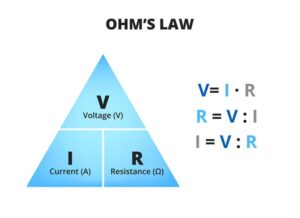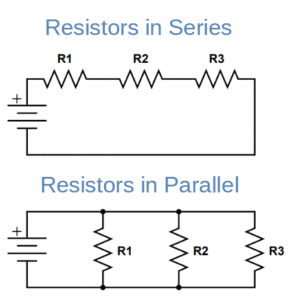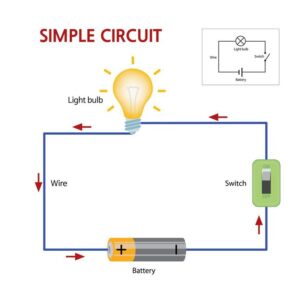Lighting Up the Mystery: How Electricity Powers Our World
Electricity Lesson Plan For Class 10
Hook – Why Did the Fan Suddenly Stop?
Its a hot afternoon. You are doing homework when the ceiling fan suddenly slows down and stops. The room turns silent, except for the creak of the turning blades coming to a halt. You know the power has gone. But have you ever wondered what really flows through those wires to keep your fan running? Its not magic its electricity.
Learning Objectives
By the end of this lesson, you will be able to:
-
Explain what electric current and voltage are.
-
Understand Ohm’s Law and how it applies in circuits.
-
Explore the effects of resistance and resistivity.
-
Compare series and parallel circuits.
-
Discover how electricity produces heat and calculate electric power.
Key Vocabulary
-
Electric Current (I) – The flow of electric charge through a conductor.
-
Voltage (V) – The force or potential that pushes electric current through a circuit.
-
Resistance (R) – A material’s opposition to the flow of electric current.
-
Ohm’s Law – A rule that relates voltage, current, and resistance.
-
Resistivity – A material specific property that affects how much resistance it offers.
-
Series Circuit – A circuit where components are connected end to end.
-
Parallel Circuit – A circuit where components are connected across the same voltage source.
-
Electric Power (P) – The rate at which electrical energy is used or produced.
-
Heating Effect – The heat produced when current flows through a resistor.
Curiosity Questions
-
Why does a light bulb feel hot after being on for a while?
-
Why are some wires thicker than others?
-
Why are homes wired in parallel and not in series?
Topic Introduction
Electricity is the reason your lights glow, your mobile charges, and your fan spins. But what really happens inside the wires? In this lesson, we will explore the science behind electrical circuits from how electrons move to how heat is produced in your iron box. Understanding electricity helps us use energy efficiently and safely in real life.
Analogies to Understand Electricity
-
Electricity is Like Water in Pipes:
Think of current as water flow, voltage as water pressure, and resistance as the narrowness of the pipe. -
Battery is Like a Water Tank:
A battery stores energy like a tank stores water. The higher the tank (voltage), the stronger the water flow (current). -
Resistors Are Like Traffic Jams:
Just as heavy traffic slows down cars, resistance slows the flow of electrons.
Core Concept Explanation
Electric Current and Voltage
-
Current (I) = Flow of electrons. Measured in Amperes (A).
-
Voltage (V) = Electric potential difference. Measured in Volts (V).
Formula:
Current (I) = Charge (Q) / Time (t)
Ohm’s Law
Ohm’s Law gives us a simple formula:
V = I × R
Where:
V = Voltage (Volts)
I = Current (Amperes)
R = Resistance (Ohms)
 Resistance and Resistivity
Resistance and Resistivity
-
Resistance depends on the material, length, area, and temperature.
-
Resistivity (ρ) is a fixed value for each material.
Formula:
R = ρ × (L / A)
Where:
R = Resistance
ρ = Resistivity
L = Length
A = Cross-sectional Area
Series vs. Parallel Circuits
Series:
-
Current is same in all components.
-
Voltage divides.
-
Total resistance = R₁ + R₂ + R₃…
Parallel:
-
Voltage is same across branches.
-
Current divides.
-
1/R = 1/R₁ + 1/R₂ + 1/R₃…

Heating Effect and Electric Power
Heat (H) = I²Rt – More current and resistance produce more heat.
Electric Power (P) = V × I – Measured in Watts (W).
Also, P = I²R and P = V² / R
Scale or Context
Even a small 100 watt bulb uses 100 joules every second. That means if you leave it on for 10 hours, it consumes 1 unit (kWh) of electricity, what you see on your electricity bill.
DIY Hands-On Activity – Build a Simple Circuit
Purpose: To observe how current flows and resistance works.
Materials:
-
A 9V battery
-
1 LED or bulb
-
2 wires with clips
-
1 pencil (graphite core as resistor)
-
A switch (optional)
Safety: Dont short the battery. Handle wires carefully.
Instructions:
-
Connect one wire from battery’s positive terminal to the LED.
-
Connect another wire from LED to one end of the pencil graphite.
-
Connect the other end of the pencil graphite to the battery’s negative terminal.
-
Observe how the LED glows dimmer due to resistance from graphite.
Concept Connection & Deep Explanation
What did we observe?
The LED glowed dimly.
Why did it happen?
The graphite core added resistance, limiting the current.
What does it show?
Resistance controls how much current flows in a circuit.

Observation / Exploration
Try changing the length of graphite (cutting pencil core smaller). Record how brightness changes. What does this say about resistance and length?
Elaboration Activity
Group Challenge:
Design two small circuits one in series and one in parallel using bulbs. Then answer:
-
Which one glows brighter?
-
What happens when one bulb is removed?
Real Life Applications
-
Electric Kettles & Irons: Use the heating effect to work more resistance means more heat.
-
Household Wiring: Parallel wiring keeps appliances working independently.
-
Electric Fuses: Thin wires with high resistance melt when current exceeds safe limits, protecting devices.
Quick Quiz
-
What is the formula for Ohm’s Law?
-
In which type of circuit is the voltage across components the same?
-
If resistance increases, what happens to current (if voltage is constant)?
Think Pair Share
Imagine if all home appliances were connected in series.
What would happen if one appliance failed? Why would this be a problem?
Main Recap
-
Electricity is the flow of electric charge.
-
Ohm’s Law connects voltage, current, and resistance.
-
Resistance depends on material, length, and area.
-
Series and parallel circuits behave differently.
-
Electric power and heating are effects of current flow.
Creative Challenge
Design an energy saving home circuit plan. Use parallel circuits and suggest where to place switches, fuses, and energy efficient bulbs.
More to Explore
-
Search: “Smart circuits in electric vehicles”
-
Investigate: “How do electric stoves work?”
-
Read: “Why are copper and aluminum used in wires?”
Student Self-Evaluation
☐ I can explain Ohm’s Law in my own words.
☐ I understood how current behaves in circuits.
☐ I enjoyed the hands on activity.
☐ I know how to calculate electric power.
Reflection
What surprised you the most in today’s learning? Was it the way circuits behave, the hands on activity, or how electricity becomes heat? Write a few lines about your learning experience.
Digital Learning Enhancements
- YouTube Animation Link: Electricity Video
- Interactive Simulation: PhET Circuit Construction Kit (DC)

